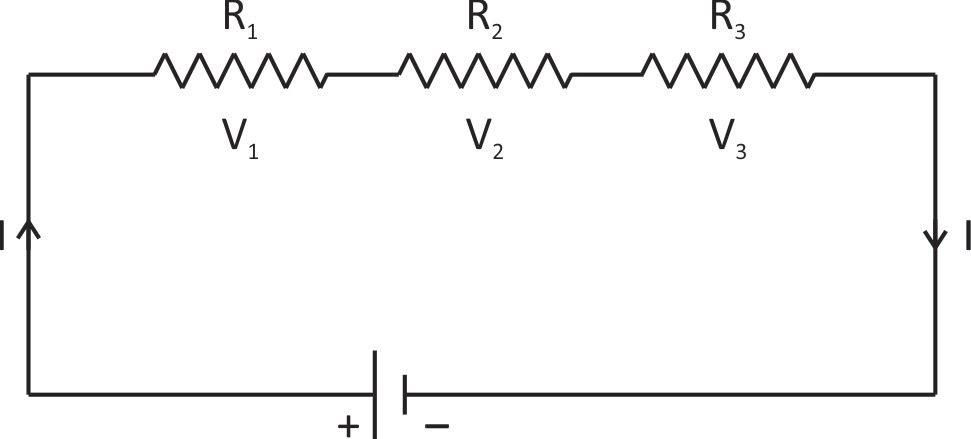
Explain and derive equivalent Resistance formula for 3 Resistors connected in Pure series. Generalize the formula?
Answer
577.5k+ views
Hint: When three resistors are concealed in derives then the same current passes through each resistor but the voltage drop is different for each resistor.
Complete step by step solution:
According to Ohm’s formula V = IR.
When three resistors are connected in series then the same current passes through each resistor but the voltage drop is different for each resistor. If V is the applied voltage and \[{V_1},\,\,\,{V_2}\] and \[{V_3}\] is voltage across resistance \[{R_1},\,\,{R_2}\,\,and\,\,{R_3}\] respectively then.
\[V = \,\,{V_1}\,\, + \,\,{V_2}\,\, + \,\,{V_3}\] …(1)
According to ohm’s law
V = IR
\[\therefore \] \[I{R_{eq}}\,\, = \,\,I{R_1} + I{R_2} + I{R_3}\]
\[I{R_{eq}}\,\, = \,\,I\left( {{R_1} + {R_2} + {R_3}} \right)\]
\[{R_{eq}}\,\, = \,\,{R_1} + {R_2} + {R_3}\]
So, the equivalent resistance or the total resistance of the circuit can be defined as a single value of resistance that can replace any number of resistors connected in series without altering the value of the current or the voltage of the circuit.
If we have n resistance connected in series, then generalized formula for equivalent resistance is
\[{R_{eq}}\,\, = \,\,{R_1} + {R_2} + {R_3}....... + {R_n}\]

We know that applied voltage is (v)
\[\therefore \,\,V = {V_1} + {V_2} + {V_3}\]
We also know that
V = IR (from ohm’s law)
\[\therefore \,I\,{R_{eq}} = I{R_1} + I{R_2} + I{R_1}\]
\[ \Rightarrow I\,{R_{eq}} = I\left( {{R_1} + {R_2} + {R_3}} \right)\]
\[ \Rightarrow {R_1} + {R_2} + {R_3}\]
So, the equivalent resistance or the total resistance of the circuit can be defined as a single value of resistor connected in series with altering the values of the current or voltage in the circuit.
Note: If three or more resistors with the same value are connected in parallel, then the equivalent resistance is equal to \[\dfrac{R}{n}\].
Complete step by step solution:
According to Ohm’s formula V = IR.
When three resistors are connected in series then the same current passes through each resistor but the voltage drop is different for each resistor. If V is the applied voltage and \[{V_1},\,\,\,{V_2}\] and \[{V_3}\] is voltage across resistance \[{R_1},\,\,{R_2}\,\,and\,\,{R_3}\] respectively then.
\[V = \,\,{V_1}\,\, + \,\,{V_2}\,\, + \,\,{V_3}\] …(1)
According to ohm’s law
V = IR
\[\therefore \] \[I{R_{eq}}\,\, = \,\,I{R_1} + I{R_2} + I{R_3}\]
\[I{R_{eq}}\,\, = \,\,I\left( {{R_1} + {R_2} + {R_3}} \right)\]
\[{R_{eq}}\,\, = \,\,{R_1} + {R_2} + {R_3}\]
So, the equivalent resistance or the total resistance of the circuit can be defined as a single value of resistance that can replace any number of resistors connected in series without altering the value of the current or the voltage of the circuit.
If we have n resistance connected in series, then generalized formula for equivalent resistance is
\[{R_{eq}}\,\, = \,\,{R_1} + {R_2} + {R_3}....... + {R_n}\]

We know that applied voltage is (v)
\[\therefore \,\,V = {V_1} + {V_2} + {V_3}\]
We also know that
V = IR (from ohm’s law)
\[\therefore \,I\,{R_{eq}} = I{R_1} + I{R_2} + I{R_1}\]
\[ \Rightarrow I\,{R_{eq}} = I\left( {{R_1} + {R_2} + {R_3}} \right)\]
\[ \Rightarrow {R_1} + {R_2} + {R_3}\]
So, the equivalent resistance or the total resistance of the circuit can be defined as a single value of resistor connected in series with altering the values of the current or voltage in the circuit.
Note: If three or more resistors with the same value are connected in parallel, then the equivalent resistance is equal to \[\dfrac{R}{n}\].
Recently Updated Pages
A man running at a speed 5 ms is viewed in the side class 12 physics CBSE

The number of solutions in x in 02pi for which sqrt class 12 maths CBSE

State and explain Hardy Weinbergs Principle class 12 biology CBSE

Write any two methods of preparation of phenol Give class 12 chemistry CBSE

Which of the following statements is wrong a Amnion class 12 biology CBSE

Differentiate between action potential and resting class 12 biology CBSE

Trending doubts
What are the major means of transport Explain each class 12 social science CBSE

Which are the Top 10 Largest Countries of the World?

Draw a labelled sketch of the human eye class 12 physics CBSE

Explain sex determination in humans with line diag class 12 biology CBSE

Explain sex determination in humans with the help of class 12 biology CBSE

Differentiate between homogeneous and heterogeneous class 12 chemistry CBSE




